The 1948 Packard sales brochure proclaims, “Excitingly new…Unmistakably Packard!” Compared to a ’47, yes, this ’48 is new. Excitingly? That’s up for debate I suppose. It actually has a bit of a Hudson Hornet “bathtub” vibe going on. Listed as a long-parked barn find, this Packard Deluxe Eight Touring sedan is located in Monterey Park, California and is available, here on craigslist for $6,500. Thanks to Ikey H. for this discovery!
I’m going out a bit on a limb here with proclaiming this Packard as a Deluxe Eight. The seller does not elaborate but the roofline appears to be correct and there are holes in the window frames where the Deluxe Eight garnish moldings were probably attached at one time. The Deluxe Eight, along with the Super Eight and the regular Eight, enjoyed this aerodynamic styling for three years, 1948-1950. Some loved it and others despised it according to media reports of the time. In 1951, styling would be greatly altered allowing for a more contemporary appearance. Like its larger sibling, the “Super Eight”, this Packard’s name is derived, obviously, from its eight-cylinder powerplant. Offered in four different body styles, a two-door sedan, a four-door sedan, a convertible, and a “Station Sedan”, Packard managed to sell 92K cars in ’48. In another ten years, the sun would set on Packard but for now, it far outstripped Cadillac’s 52K units and Lincoln’s paltry 7K copies.
The seller advertises this Packard by stating, “barn find, complete car, no rust, super straight, unmolested car and engine, not running, owned and not moved by (the) same family for over 40 years…” Rust seems to be a debatable term and in the case of this Packard, it probably means no rust-through. There is obviously surface rust in places and a bit more than that lurking around the driver’s side turn signal and in some of the body seams. In particular, the rust spread across the trunk lid is curious. While being a barn find that has been squirreled away for many years, this Packard obviously has seen some outdoor time based on how faded the finish is. The body panels, however, appear to be straight, as are the bumpers, and there is no indication of crash damage. Interesting to note are the side view mirrors, they appear to have been plucked from some other car and planted on the doors, probably in an attempt to enhance safer driving or as the result of a legal requirement.
Power is provided by a 130 HP, 288 CI, in-line eight-cylinder engine. This Packard is a non-runner and a non-mover as it has occupied that same resting place for 40 years though the seller advises that he has replaced the tires with used ones that will actually roll. The images of the engine aren’t the best but it appears as if everything that is supposed to be there, actually is. The seller states that if he can get it running, “the price will go up“. A three-speed manual transmission handles gear changes. Good to see that there is a “Workaholic” 6-volt battery in place.
The interior is not well represented pictorially. The instrument panel, while complete, is surprisingly spartan for this era luxury automobile. The remainder of it looks tired with worn door cards and kick panels and a stained, faded bench seat. There is a radio in place and you can see where the antenna, that was once attached to the roof, right above the center of the windshield, is no more. The condition of the floors is indeterminable based on the images provided.
It’s always nice to find a member of a “fallen flag” of former auto manufacturers. And Packard, in particular, was an esteemed and noteworthy brand. The underlying issue today is the interest, or lack thereof, in cars like this Packard Eight; it would seem as if the appeal has narrowed considerably. Hopefully, salvation will be in its future, it would be a worthy endeavor. After all, all you need to do is ask the man that owns one, right?
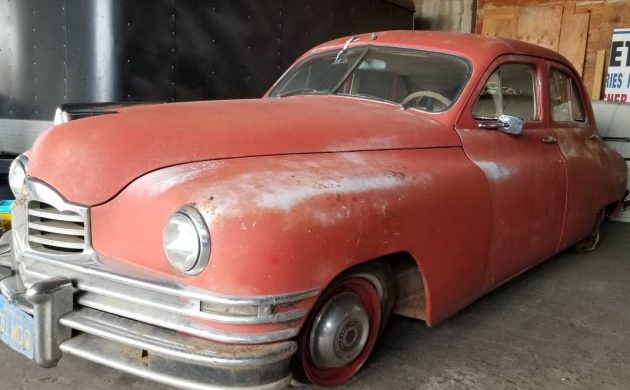

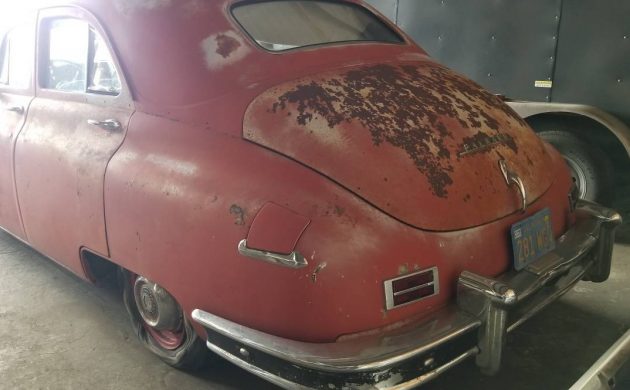
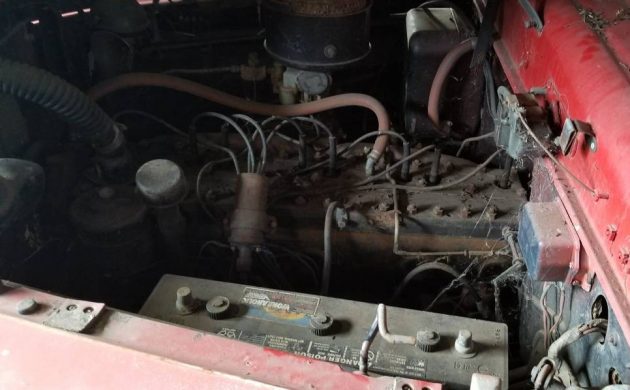
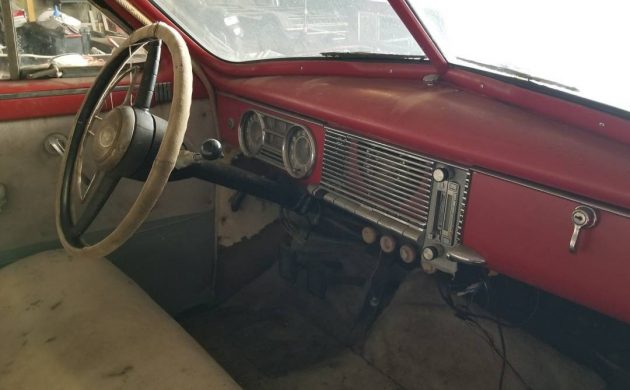
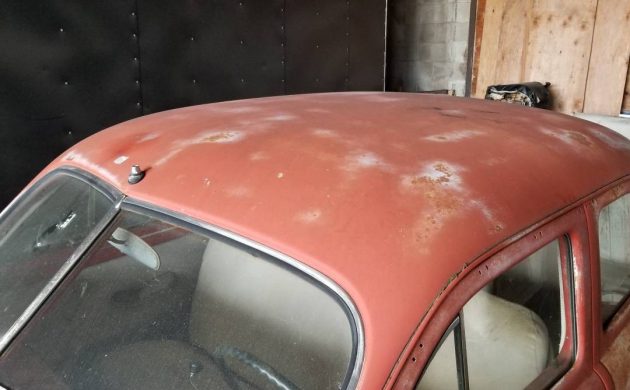


You can ask me,,,,because I owned one. While that motto wouldn’t fly today, it sold a lot of cars. Always fun to see these come up here, and I’m not bitter, like rubbing my face in it, more of a tribute to me and mostly, my grandfather, who bought a new Custom 8 in 1948. It was his 1st new car. I think most, like my grandfather, bought Packards, not because they were superior, they still had pre-war engineering, but more for Packards contributions to WW2. Without Packard, we may not have won the war, and people like my grandfather, and anyone in the Air Force, would agree. In case some don’t know, they partnered with Rolls-Royce Merlin, and made a wicked airplane motor, a fascinating subject in itself.
This is a great find, Bill M. is more of an expert on these, looks pretty basic. They had a jillion trim options. That dash was repainted, sadly, as they all had a neat painted wood grain finish and that’s not the original radio. It was a big tube thing, and cost my grandpa, $38 bucks! A hefty option costing almost $500 bucks today! Also, no Cormorant hood ornament. That cost my grandpa $18 bucks, or over $300 today. Luckily, my grandpa kept the hood ornament when he wrecked the car in 1961 and the hood ornament shown on our car, was that hood ornament.
Also, this car does not have the electro-matic clutch, like my grandpas had. Mine was the 1st year ( 1950) for the Ultramatic. It was a complicated feature, that used engine vacuum to suck the clutch pedal down. My dad, who remembered driving in it, said it worked rather well.
Again, same old ting, I know 1st hand, these are a bear to restore. I had the luxury of 3 parts cars, and quite frankly, were just like this. I bought 2 complete cars once, for $300 bucks, just to get the visor, and a bunch of other stuff, you’d go broke today buying it separate. This Kanter, in NJ, has everything you could possibly need, mechanical wise, body and interior parts, good luck. Thanks for the post, it always makes me feel good, and reminds me of my grandpa Sam.
@Howard: It’s always a plus to me to hear from someone who actually owned one of the subject vehicle! Nothing like the personal reminisces of trials/tribulations endured in order to get/keep their “baby” operational! :-)
The widow that owned the car said, her husband parked the car on blocks in 1959, when he refused to pay more than .25/gallon for gas. We also had the 288, the smallest motor offered, and after sitting 30 years, it too was stuck. I think it was a combination of WD-40 and diesel fuel that ultimately loosened it up, and as a testament to Packard motors, after getting it started, it ran just like I imagined it ran in 1959. I never did anything else to the motor. You could actually balance a nickel on the cylinder head when running.
Looks like yours and this one had the same original color. That red is definitely a bad re-spray. Well, probably, at least.
The Ultramatic had NO clutch pedal.What you described was a vacuum operated clutch for a 3 speed standard shift.Another wretched idea was vacuum windshield wipers.I think Chrysler went to electric wipers in 1939 and never went back.
Bob,
The automatic clutch was called Electro-Matic Drive. I think Howard was referring to the E-M D in his comment, but the line about the Ultramatic equipped car got in the way!
And I will defend the vacuum wipers, WHEN THEY WERE NEW, THEY WORKED NICELY. But as the vacuum pump begins to fail, and the wiper vacuum motor gets gummed up with old grease, they are terrible. that said, with a rebuilt fuel/vacuum pump and a properly rebuilt wiper motor with a new seal on the reversing flap inside, they work well.
Most people don’t know why cars like Packard used vacuum wiper motors. the reason was simple; compared to the electric motors of the era, they were almost totally silent. Packard also used the Trico cable system that had the ability to self-tension the operating cables to the wiper bases.
Many years ago I had the opportunity to experience Packard Club member Don Rook’s 1948 Packard Custom Eight with only about 600 actual miles! Sitting in the car I could not hear [or feel] the engine, the wipers, or the exhaust. The car was truly silent.
Compared to a 1948 Packard Custom Eight sedan, an equally maintained 1948 Rolls-Royce Silver Wraith is not nearly as quiet as the Packard. I know, I’ve had several examples of each. I’ll gladly take the Packard.
Howard,
I’ve owned at least forty 1948 to 50 Packards, from the lowly Standard Eight sedan, to the Custom Eight limousine. I currently own a 1948 Super Eight Convertible and a Super Eight sedan.
You are correct the interior metal panels have been painted red instead of wood grained. The window surround panels have a chrome strip down the center, those were on the Super Eight cars. Car was originally black. To re-do the interior metal panels correctly will cost more than the car is currently worth.
This car is the bottom line Standard Eight, easily spotted by the plain single panel upholstered seat backs and plain door panels, and no chrome belt line trim from the front edge of the doors to the wiper bases. It has one option; a heater, but not even a radio or overdrive. To drive this for any real distance, at speeds over 50, you need overdrive, and adding OD can cost over $1,500. This would use the Borg-Warner R-9 OD, and they are getting hard to source.
The doors show they had a chrome trim on the upper edges of the window frame areas. This trim was only available on the top-of-the-line Custom Eight, so the doors have been replaced on this car. The bumper guards are also from a Custom Eight as well. The hubcaps are incorrect, they belong on 1951 or 1952 Packards. The trunk lid shows a couple of mounting holes on the side edges, but not all the way around the edge. That means it was from a Super Eight.
This car is a marriage of multiple Packards.
I will say it does have one good selling point, it appears to be a solid, rot-free body. For those who live east of the big river, that’s hard to find. And it’s only the second one I’ve ever seen painted bright red!
Never had a 50’s Packard, but I owned a ’37 and a ’38 years back. These cars were overbuilt and a testament to American engineering.
I’m glad that someone has finally pointed out that Packard’s Free-Flo styling for 1948 was so popular that it outsold the Cadillac about 2 to 1. I’d add that it also DOUBLED Packard’s sales, proving that those who hated it were way out of touch with the car buying public. Alas, the cantankerous Ultramatic introduced in 1949 by Packard nuked its sales in the same year Cadillac came out with and ohv V8 and the faithful Hydramatic, and the downward spiral began.
Price is a little high for a non running 4 door, but more info is needed as to rust in floors and more importantly under the door sills. The lack of electro magic clutch is a plus, but lack of overdrive is a minus. Curiously, the radio and heater were “required options” in these cars. I have a 49 Standard Club Coupe. That will hopefully win an AACA Senior at Charlotte this year. It never comes out in the pics, but these are gigantic cars, and are one of the few cars one can enter while wearing a fedora. Tho inside really is like a living room, and the seats are like sitting on a cloud.
Dualjetfire,
I’ve always found it interesting that of the entire line of Packards, including the limousine, NONE had the radio as standard equipment! On the base models like the Standard & Deluxe series cars [and the rare 22nd series 6 cylinder cars] the heater was optional equipment, but standard on the Super Eight models and above. [I have all the original factory option lists and prices for options.]
You are quite right that Packard outdid Cadillac for the 22nd series cars, but as for the original Ultramatic being a problem, they were actually quite trouble-free. it wasn’t until the advent of the 1954 Packard “Gear start” 3-speed with the lock-up torque converter [something Ford later claimed to invent], later called the Twin Ultramatic for the V8 Packards, did they begin to have transmission problems. Packard DID rush that new trans into production before getting all the bugs worked out. But by 1958 they had figured out and solved the big problems for most of them.
A 1949 Packard Standard Eight Club Sedan is not a common car to see today. Few Packard dealers would order the base model 2-door cars unless a customer placed a deposit. Most of the Club Coupes are Deluxe or Super cars.
I’ve always maintained that these cars are deceptively large, I believe it’s because of the smooth body panels, there is little for the eye to “stop” to look at.
And did you know a new 1948 Super Convertible was on display at the New York MOMA museum, and Packard was awarded all EIGHT of the major styling awards for 1948? Sadly, like the Nash Airflyte and the 50-51 Studebakers, Packard styling didn’t age well. The 1950s were a time of great styling change for cars, and most of the pre-1955 cars didn’t age well.
Looks like the rear end sat under a bird perch part of the barn. I do love the size of that 6 volt battery as it reminds of the ones that used to sit in my old man’s Hudson Super 6
A 6 volt farm tractor battery, and still available today. Interesting note, there was a square hole in the inner fender, and the side of the battery was exposed to the elements, I imagine, in an effort to cool the battery.
Howard,
That’s exactly right!
very nice on whole or details and – there it is, my fav, an i8 motor…tq city, dude !
The Ultramatic worked fairly well until they coupled it to the powerful V8 in ;late 1954.The sedate performance of the inline engine gave smooth performance.
I have owned 1935-1951-1952-1953 and a 1955.Packards.The 1955 was a Patrician and transmission problems were prevalent.The 52 and 53 were standard 3 speeds and the 53 had an overdrive.The 51 was a much later purchase in 1988 and it was a one owner 200 series 4 door sedan that was stored for 22 years in a garage.I replaced all 16 valves,got it running and drove it for a year until the transmission acted up.I pulled it,repaced the clutch pack and cleaned the babbit shavings out of the valve body and made new bronze bushings to close tolerances and after reinstalling it I
noticed the transmission had a positive action and the direct drive clutch engagement was firm with no slippage.I drove it until 1992 and then sold it.
That babbit bearing the converter hub ran in was a very poor idea and that hub also turned the front oil pump in the transmission.If you want to test an Ultramatic Packard after rebuilding it,coast it downhill,turn the key on and pull the selector into DRIVE and if the engine starts,the clutch works.
These are fun cars to drive. I bought a 1950 Deluxe Eight seven years ago. A newly rebuilt carb this Spring really brought the straight 8 to life. Always enjoy reading the history of Packard. I don’t get to drive it nearly enough, my goal is to rebuild brakes this Spring and enjoy the ride.
If the brakes are weak install a very loud horn.On a serious note,
IF the brakes are the same as the 1951,the brake shoes from a 1973 International Travelall.brake lining manufacturers code is 30;
new brake lines mandatory.Master cylinder rebuild also.
10-4 on the horn 😂
Thanks for the info, much appreciated.
Greg,
2 things;
1. join the Packard Club [PAC]. it’s the cheapest investment you will ever make for your Packard!
2. If you have questions about working on your Packard, don’t hesitate to email me; [email protected]
“Barn Freed” Wasn’t that Elsa the lion?
Most vacuum operated wipers were simply driven off the intake manifold, not a vacuum pump. Which is why they would slow down on heavy acceleration – like when you swung out to pass, for example! A hell of a time to lose visibility in the pouring rain. As is stated so often here: “Ask me how I know”.
Kenn,
All Packards with vacuum wipers came with a dual action fuel & vacuum pump, 1948 to 1954. In 1955 they changed the vacuum pump location to the end of the oil pump housing. Early versions had a problem with oil pressure fluctuation because of vacuum leaks, but this was solved by 1956. [Always rebuild an original 1955 pump to the 1956 spec.]
Over the years I’ve been known to take a 1970s ford vacuum tank [looks like a black painted 1 pound coffee can] and hide it under the dashboard, to provide additional wiper vacuum.
The only problem with this is if you forget to turn the wiper knob to the off position when turning off the engine, the wipers will continue to work until the vacuum can reaches normal atmospheric pressure!
Lots of Packard experts, OK so I have a question. When I was younger I stumbled on a 55 Packard Clipper sedan. It had a smooth V8 and a manual trans. It was a little rough but the old girl ran great.
Looking at 55-56 Packards I haven’t seen another manual trans. It is safe to say the manual was reserved for the Clipper?
These cars used a LONG narrow battery that was hard to get to and very heavy.I think they were also positive ground.
Standard shift 55 and 56 Packards are very rare.The dealer here where we live would not order them and would tell customers they were not available.They were told,apparently by the factory to push the Ultramatic.Not giving the customer what he wanted was a stupid decision on what was SUPPOSED to be a luxury car.
Another thing that was against Packard was the rapid depreciation and low trade in value.The 1955 Patrician that was such a pain in my neck was for sale at the local Pontiac dealership that shared a lot with the Packard dealer and I mistakenly gave up my 1953 four door Packard and $600 for
this fancy clunker.
AMCFAN,
Officially, the 1955-56 Packard senior cars [Patrician sedan, The 400 2-door hardtop, and the Caribbean convertible or hardtop, were equipped only with the Twin Ultramatic transmission, but the actual situation, based on the company’s own pricing paperwork for their dealers, showed that only the Caribbean came with the Twin Ultramatic at no additional charge.
The junior line of cars [Clipper Deluxe, Super, and Custom], came with 3-speed stick shift as base equipment, and all were available with overdrive or the Twin Ultramatic at additional charge.
In 1956 All Packards & Clippers were available with the new push button electric shift, a set of 6 buttons in a square pod where the shift quadrant lever would have been located. The push-button setup was standard on the Caribbean models.
V8 Packard experts suggest that only about 150 Overdrive cars were sold, very few were senior cars. I used to own one of them. It was a 1955 Packard 400 hardtop, Turquoise with white top and white lower side panels. Not only was it an overdrive transmission, but it also had factory air conditioning!
The original purchaser was a contractor and builder, who was often driving in construction sites, so he wanted stick shift. When the Packard Twin Traction rear differential was introduced in 1956, he had the entire axle replaced, with a 3.07 ratio.
The combination of the overdrive and 3.07 rear diff ratio meant that I could easily reach 60 MPH before having to shift into third gear! In 1976 I found a complete dual quad setup, from the manifold to the air cleaner, and I added it to the car.
One memorable event happened about 1978, I was talking to a guy who had a 1955 Chevy Bel Air 2-door with the SBC and 4-speed, he [as a joke] asked me if I wanted to race, so I said sure!
We lined up, and I pulled out on the electric antenna switch on the dash. The antenna switch was hooked up to control the self leveling torsion bar suspension, and in pulling the knob out, it energized the suspension leveling motor, raising the back end of the car to match the rake on his Chevy!
Once launched, I kept the shifter in first, letting off to get the OD to engage, then shifted into second gear. Flooring the gas pedal, it shifted out of OD, and at about 60 I shifted to third gear. Flooring the gas pedal again, I kicked out the OD and kept going, finally backing off just enough for the OD to engage again.
There was no official timing system or anyone to watch the end results, but we basically agreed it was a tie. He asked me what kind of a transmission I had in the Packard, he thought I had installed a big semi-truck transmission. Nope, just the regular Packard OD trans, that allows the driver to use the OD in every gear.
That was the only time I ever raced that Packard.
I knew Bill would shed some light, couple things, my 1950 was the Ultramatic, and it was the Electromatic clutch on my grandfathers car I was referring to. We found the original bill of sale from Edwards Motor in Milwaukee, and it made no mention of that feature. I wonder if it was standard on the model he bought, a Custom 8, I think. My 1950 had those hubcaps, which I doubt were replaced at any time, and the starter on the gas pedal proved a hassle when hot,but the most annoying feature, the “whistling gas filler”. Before auto-shutoffs, the tank whistled while filling and would stop just as it got full. It was so loud, people at the gas station looked around to see where that irritating whistling was coming from. It got to the point, I’d fill gas cans in the pickup and take them home. A note on the Ultramatic. It was the 2nd fully automatic to be offered, GM the 1st. It was a slushy thing, but a stout unit. It was updated when the V8 came out, the “Twin Ultramatic”, developed by a then young John Z. DeLoren.
Lincoln bought Hydramatic transmissions from GM with no loss of “prestige”and maybe if Packard had done that they might have hung around a whole longer.The 1956 Packards were possibly the best looking cars of that time.I live near Southern Ohio and
there was a 1955 Clipper that was driven until the early 1980’s but under the hood and under the floor was an Oldsmobile engine and Hydramatic,
Howard,
Back before federal law required the manufacturer to post the window sticker with prices and options listed, theselling dealers were free to create their own window sticker [or post nothing at all].
The Electro-Matic clutch and overdrive were not standard equipment, but 99% of all Custom Eights had them both. In order to get the EMC, you had to get OD. Because the dealer typed up their own sticker, they could list those options as “included” in the base suggested price.
The hubcaps on the red Packard are 100% 1951 & 52 caps. They won’t fit onto the 1950 & back wheels, but the wheels are interchangeable. Either your car had updated wheels, or your memory is [like mine] subject to change. It’s an easy mistake anyway, there is not a lot of difference on the outside, but the mounting methods are different.
Back when I would allow pump jockeys to fill the tank on my Packards, I would try to warn them in advance, telling them to stop filling when the whistle stopped. If they allowed the fuel to fill until the automatic shut-off kicked in, they usually had a lot of fuel splash out.